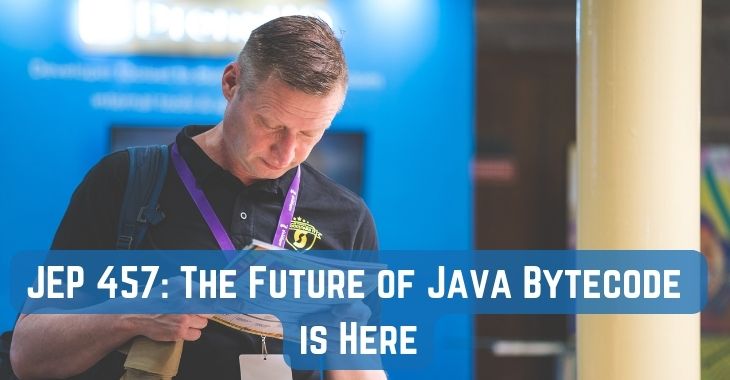
“Once again Saltmarch has knocked it out of the park with interesting speakers, engaging content and challenging ideas. No jetlag fog at all, which counts for how interesting the whole thing was."
Cybersecurity Lead, PwC

This article delves into the transformative impact of JEP 457 on Java bytecode manipulation. From its promising vision to complex design considerations, and from community involvement to future prospects, we cover it all. Whether you're a Java developer, a tech enthusiast, or simply curious about the future of Java, this is your go-to guide for understanding the significance of JEP 457.
The Java ecosystem is abuzz with excitement, and for a good reason. The spotlight is on JEP 457, a Class-File API proposal that could really change things by shifting how developers work with Java bytecode. For years, ASM has been the go-to library for bytecode manipulation, but JEP 457 is poised to challenge this long-standing status quo.
So, what makes JEP 457 so special? For starters, it aims to standardize what has been a fragmented space. By offering a unified approach to parsing, generating, and transforming Java class files, it simplifies what has traditionally been a complex and error-prone process. This standardization has far-reaching implications, potentially affecting everything from individual development projects to enterprise-level applications.
But it's not just about the technical specs; it's also about timing. As Java continues to evolve, the need for a more streamlined and standardized way to handle bytecode has become increasingly apparent. JEP 457 arrives at a moment when the community is actively seeking solutions to these challenges, making its introduction both timely and relevant.
JEP 457 is not just a small change; it's creating a big impact in the OpenJDK community. Its core aim is to standardize the parsing, generation, and transformation of Java class files, which are the bytecode representations of Java source code. These class files are the building blocks that power the Java Virtual Machine (JVM), the engine that runs Java applications. By offering a standardized approach, JEP 457 aims to solve a long-standing problem in the Java ecosystem: fragmentation. Developers often have to navigate a maze of libraries and tools, each with their own quirks and learning curves, to manipulate bytecode. JEP 457 promises to simplify this landscape by becoming the go-to API for class file operations.
The proposal comes at a time when the Java community is increasingly focusing on performance optimization and code maintainability. By providing a unified, standardized API, JEP 457 not only makes it easier for developers to write efficient code but also simplifies the task of maintaining and updating that code in the long run. This is particularly important as Java applications continue to grow in complexity and scale, making the need for efficient and maintainable code more critical than ever.
The API is currently in a "preview" phase, a critical stage that allows developers to experiment and provide real-world feedback. This feedback loop is integral to the API's development, as it helps identify gaps, bugs, or usability issues that may not be apparent to the core development team.
Brian Goetz, a key architect for the Java language at Oracle, emphasized this point in his recent talk at the JVM Language Summit. Goetz highlighted the importance of user ergonomics, stating that an API's success is measured not just by its technical capabilities but also by how easily developers can adopt it. This is a crucial insight, as it aligns with broader community expectations for an API that is both powerful and user-friendly.
The OpenJDK community's active participation in the preview phase serves as a real-world testing ground for these ergonomic principles. Developers are not just passive consumers of the API; they are active contributors to its refinement. Their feedback directly influences design decisions, ensuring that the API is tailored to meet the actual needs of the Java development community.
The design process behind JEP 457 was far from simple, revealing the team's commitment to delivering an API that goes beyond mere functionality. Initially, the team had what could be considered a functionally complete API. However, they chose to revisit it, a decision driven by their commitment to user ergonomics and overall user experience. This wasn't a one-off revision; it led to multiple iterations, each aimed at refining the API to align more closely with what would make the end-users happy.
The team's focus wasn't just on meeting technical specifications; they were equally committed to adhering to the guidelines and specifications laid out by the Java Data Model (JDM). This dual focus on technical and user-centric design exemplifies the holistic approach taken by the team. It also underscores the importance of iterative development in software design, particularly for something as foundational as a new API for Java class file manipulation.
Java class files are complex; they have detailed structures that include lists of methods, fields, and attributes. Each of these elements can have its own set of attributes, adding another layer of complexity. This is more than just a theoretical challenge; it's a practical hurdle for developers who need to navigate these files for various tasks like debugging, optimization, and feature development.
The team behind JEP 457 recognized this complexity as a significant barrier to entry for many developers. Their solution was not just a band-aid fix but a thoughtful redesign of how developers interact with Java class files. They aligned the reading and writing APIs, so developers no longer have to switch mental models when moving from reading to writing operations, thereby reducing cognitive load and potential for error.
But the team didn't stop there. They introduced the concept of "builders", a design pattern familiar to many developers. These builders simplify the process of creating class files by providing a more intuitive, step-by-step approach to constructing complex objects. This is especially beneficial for those who are new to bytecode manipulation, as it offers a more accessible entry point.
The result is an API that not only simplifies individual tasks but also makes the entire process of working with Java class files more straightforward.
The Java landscape is filled with tools and libraries that tackle similar problems but in slightly different ways. This fragmentation complicates the development process and hampers long-term project maintainability. Imagine having to update or migrate a project that relies on multiple, slightly different libraries for bytecode manipulation. The complexity can quickly become overwhelming.
JEP 457 aims to cut through this noise by offering a unified library for class file manipulation. To address the API's scope and flexibility, the OpenJDK community could develop extensions that cater to specific needs. This would make the API more adaptable without bloating its core functionality. The idea of taking inspiration from CDI Portable Extensions, as suggested by community member exabrial, aligns well with Goetz's focus on user ergonomics.
Introducing a new standard without considering compatibility could lead to fragmentation, the very issue JEP 457 aims to resolve. One approach to ensuring compatibility is the development of interoperability standards. These standards could serve as a bridge between JEP 457 and existing tools, allowing for a smoother transition. The OpenJDK community, with its extensive knowledge of existing bytecode libraries, could play a significant role in shaping these standards. Their input would be particularly valuable in identifying edge cases or potential pitfalls that might not be immediately obvious.
Brian Goetz's insights into the complexities of class files could also inform these standards. His focus on user ergonomics suggests that any compatibility solution should not just be technically sound but also easy for developers to implement. This dual focus on technical robustness and usability could guide tool developers in adapting their products to work seamlessly with the new API. Additionally, comprehensive guides and educational resources, reviewed by the community and in line with Goetz's user-centric design philosophy, could encourage widespread adoption.
While the primary focus of JEP 457 has been on standardization and user ergonomics, performance hasn't been overlooked. It's a common misconception that focusing on user experience comes at the expense of performance, but the team behind JEP 457 has shown that the two can coexist. They've implemented several techniques to ensure that the API operates efficiently, even when handling complex class file transformations.
One such technique is constant pool sharing, a method that minimizes the computational work needed for transforming class files. This is particularly important because bytecode manipulation is often a performance-sensitive operation, especially in large-scale applications where even minor inefficiencies can add up. The team's approach to constant pool sharing was informed by a key observation: most transformations only modify small portions of a class file.
By adopting a "lazy" strategy in parsing, inflating, and rewriting class files, the team was able to optimize performance without sacrificing functionality. This means that the API only does as much work as necessary, avoiding unnecessary computations and thereby speeding up the entire process. It's a balanced approach that serves the dual purpose of making the API both user-friendly and efficient.
Online discussions reveal a mix of surprise and cautious optimism about JEP 457. The community's diverse reactions are not just chatter; they're a form of crowdsourced vetting that could play a significant role in the API's future development. However, the road to widespread adoption is fraught with challenges. Transitioning to a new standard API will require time and resources, which could be a significant barrier, especially for larger projects. The community's concerns about migration headaches underscore the importance of a smooth transition strategy. This is in line with Goetz's emphasis on performance considerations, where he highlighted the use of techniques like constant pool sharing to minimize the amount of work needed for class file transformations.
As we wrap up our deep dive into JEP 457, it's clear that its potential impact on the Java ecosystem could be significant. If it succeeds in becoming the new standard for class file manipulation, we could see a significant shift in the landscape. The long-standing go-to library, ASM, might see a decline in usage for new projects, making way for a more unified and cohesive Java ecosystem. In this new world, tool interoperability would become the rule, not the exception, streamlining development processes and enhancing project maintainability.
However, the success of JEP 457 is not a foregone conclusion; it's contingent on a multitude of factors. These include its technical design, the scope of its capabilities, and its compatibility with existing tools and libraries. Each of these elements will play a critical role in determining whether JEP 457 can transition from a promising proposal to a widely-adopted standard.
Active community involvement is another crucial factor. The OpenJDK community, industry experts, and everyday developers will all have a role to play in vetting, refining, and ultimately adopting this new API. Their collective insights and feedback will be invaluable in shaping JEP 457 into a tool that meets the community's diverse needs.
With its strong focus on user ergonomics and a design philosophy that values community feedback, JEP 457 is well-positioned to become a cornerstone in modern Java development. It has the potential to redefine how we think about bytecode manipulation, setting a new standard that could benefit the Java community for years to come.
Have questions or comments about this article? Reach out to us here.
Banner Image Credits: Attendee at Great International Developer Summit

“Once again Saltmarch has knocked it out of the park with interesting speakers, engaging content and challenging ideas. No jetlag fog at all, which counts for how interesting the whole thing was."
Cybersecurity Lead, PwC

“Very much looking forward to next year. I will be keeping my eye out for the date so I can make sure I lock it in my calendar."
Software Engineering Specialist, Intuit

“Best conference I have ever been to with lots of insights and information on next generation technologies and those that are the need of the hour."
Software Architect, GroupOn

“Happy to meet everyone who came from near and far. Glad to know you've discovered some great lessons here, and glad you joined us for all the discoveries great and small."
Web Architect & Principal Engineer, Scott Davis

“Wonderful set of conferences, well organized, fantastic speakers, and an amazingly interactive set of audience. Thanks for having me at the events!"
Founder of Agile Developer Inc., Dr. Venkat Subramaniam

“What a buzz! The events have been instrumental in bringing the whole software community together. There has been something for everyone from developers to architects to business to vendors. Thanks everyone!"
Voltaire Yap, Global Events Manager, Oracle Corp.